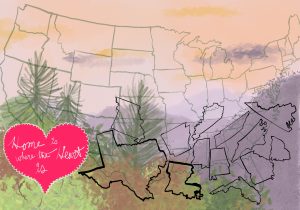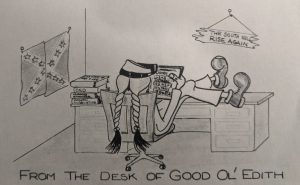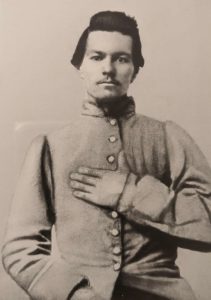Postcard 1

When I first began making a postcard with a map on it, I was planning on creating a much more straightforward map of the Confederacy. I was torn about how to show states like Kentucky and Missouri, which were claimed by the Confederacy but always controlled by the Union, or territories like New Mexico and Arizona, which seceded with the Confederacy but were regions with almost entirely different borders. However, upon reflecting I realized that such a map would reflect a Confederacy which never existed in reality or even in the mind of contemporary Confederate sympathizers. Instead, I drew the states of the Confederacy falling out of a more traditional map of the United States. They are not cohesive, and they are no longer connected to the idealized America which I drew as a background for the postcard. In short, I wanted to show the Confederacy as a product of disconnection.

The history of my grandmother’s life is complicated. She was raised in rural Georgia and North Florida by her single-mother with her two younger sisters. As a child, my grandmother’s family made a point of swimming at some of the only integrated beaches in Florida, and by the time my grandmother was in high school she was slashing the tires of local members of the KKK on her way home from school. However, when my grandmother was a young English professor in Pittsburgh, one of her students drew this cartoon for her. My grandmother passed away when I was in middle school, so I never got the chance to ask her what her Southern heritage meant to her. I never even saw this cartoon until after she passed away, so I can only guess what her thoughts and feelings about it might have been. However, after spending a semester researching and thinking about what it means to be a white Southerner in the 21st century, I have a few guesses. Like my grandmother, I was raised in the South and now live in the North East—it’s like living in a different country. I have had everything from my accent to the food I eat made fun of by my friends here, and while these experiences do not excuse sympathizing with the Confederacy, they are deeply isolating. I began this project with this image in mind, trying to understand what it meant to my grandmother. Now, I would guess that she saved this image out of a sense of loss and nostalgia for the home of her childhood, which by the time she was an adult had almost entirely disappeared to industrial paper mills.

This is a photograph of my great-great-great-grandfather, wearing his uniform as a Confederate soldier. I do not know his name, but this image and a few stories of his life have been passed down to me as part of my southern heritage. He was from the small town of Gibson Georgia, and was probably a farmer. For much of my life, his photograph went unnoticed on a wall of my house, but ever since I learned who he was, and what he fought for, it has disturbed me greatly to see him nestled among the family photos. In many ways, this display is a microcosm of the phrase “heritage not hate”—a phrase which has been a motivating factor in my research for this project. Although I do not believe that anyone in my family sees this image as anything other than a symbol of our Southern heritage, it is nevertheless a hateful image.
